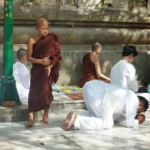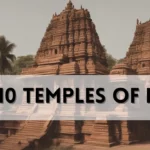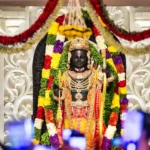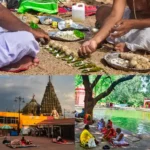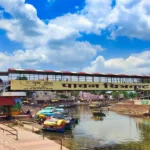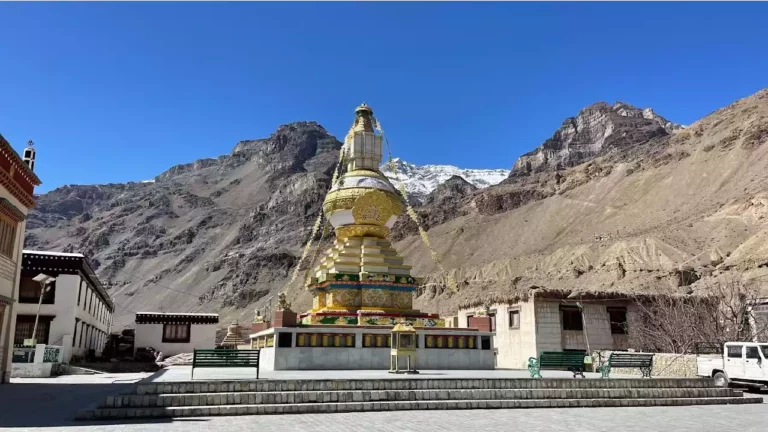Bhaja Caves, Maharashtra: An Ancient Odyssey into Buddhist Rock-Cut Splendor
Historical Backdrop
Carved into the green hills of the Sahyadri range near Lonavala, Maharashtra, the Bhaja Caves stand as a testament to the early phases of Buddhist architecture in India. Dating back to the 2nd century BCE, these rock-cut caves offer a fascinating glimpse into the evolution of Buddhist thought, art, and monastic life during the Mauryan and Shunga periods.

Architectural Grandeur
The Bhaja Caves complex comprises 22 caves, each showcasing the exemplary craftsmanship of ancient Indian artisans. The caves are categorized into chaityas (prayer halls) and viharas (monastic quarters).
Main Chaitya: The most prominent structure is the main chaitya, which houses an intricately carved stupa. The wooden beams, although replicas of the original, give an insight into the architectural techniques of the time. The horseshoe-shaped entrance, characteristic of early Buddhist rock-cut architecture, adds to the cave’s grandeur.
Viharas: The viharas, or monastic cells, are adorned with exquisite carvings depicting scenes from the Jataka tales, and the stories of Buddha’s previous births. These carvings serve both an artistic and educational purpose, narrating stories of morality and virtue.
Unique Features
Relief Carvings: One of the standout features of the Bhaja Caves is the rich relief carvings that adorn the walls. These carvings depict scenes from everyday life, providing valuable insights into the socio-cultural milieu of ancient India.

Waterfall: Adjacent to the caves is a seasonal waterfall, which cascades down the rocky facade, adding to the site’s natural beauty and serenity.
Ancient Inscriptions: Several inscriptions can be found within the caves, detailing donations made by individuals for the construction and maintenance of the caves. These inscriptions offer a glimpse into the patronage and support that Buddhist establishments received from the community.
Spiritual Essence
While the Bhaja Caves no longer function as active monastic centres, the aura of tranquillity and spirituality still permeates the site. The echoes of ancient chants, the cool interiors of the rock-cut chambers, and the panoramic views of the surrounding landscape make it a serene spot for reflection and meditation.
Significance in Buddhist Circuit
The Bhaja Caves, along with the nearby Karla and Bedsa caves, form an essential part of the Buddhist circuit in Maharashtra. These caves collectively highlight the prominence of the region as a significant centre for Buddhist learning and art during ancient times.

Conclusion
The Bhaja Caves are not just archaeological marvels but also windows into the rich tapestry of India’s Buddhist heritage. As you traverse the dimly lit chambers and gaze upon the ancient carvings, you are transported back in time, connecting with the spiritual quests and artistic endeavours of a bygone era.
For history enthusiasts, spiritual seekers, and art lovers, the Bhaja Caves offer an unparalleled journey into the heart of ancient Indian Buddhism.
Nalanda, Bihar: The Ancient Epicenter of Buddhist Learning and Wisdom
Historical Context
Nalanda, located in the modern-day state of Bihar, stands as a symbol of India’s ancient academic and spiritual prowess. Established in the 5th century CE, Nalanda University was one of the world’s first residential universities and a beacon of Buddhist learning and scholarship. At its zenith, it attracted scholars, monks, and students from as far afield as China, Tibet, Korea, and Central Asia.

Architectural Brilliance
The ruins of Nalanda spread over 14 hectares, revealing a well-planned layout comprising monasteries, temples, meditation halls, and classrooms—the red-brick structures, though in ruins, showcase the grandeur and scale of the ancient establishment.
Stupas: Scattered across the site are numerous stupas adorned with intricate carvings depicting scenes from the life of Buddha and various Jataka tales.
Monastic Quarters: The remains of the monks’ quarters, with their small cells and communal courtyards, provide insights into the monastic life of the scholars who resided here.

Academic and Spiritual Legacy
Diverse Curriculum: While primarily a centre for Buddhist studies, Nalanda’s curriculum was diverse. Subjects like astronomy, medicine, mathematics, logic, and metaphysics were also taught, reflecting the holistic approach to education.
Library: The university boasted a massive library named “Dharmaganja” (Mountain of Truth). It was a three-story structure that housed thousands of manuscripts, making it one of the largest libraries of the ancient world.
Prominent Scholars: Nalanda was home to several renowned scholars like Nagarjuna, Aryadeva, and Dharmapala. The Chinese traveler and scholar, Xuanzang, also studied and taught here, leaving detailed accounts of the university’s magnificence.
Decline and Revival
Nalanda’s decline began in the 12th century following invasions and subsequent destruction. The once-thriving centre of learning lay in ruins for centuries until archaeological excavations in the 20th century brought its legacy to light.
In recent years, efforts have been made to revive Nalanda’s academic spirit with the establishment of Nalanda University in 2010, aiming to recreate its former glory as an international centre for education and research.
Modern Significance
Today, Nalanda is not just an archaeological site but a symbol of India’s rich academic and spiritual heritage. It serves as a reminder of the subcontinent’s contributions to global knowledge and spirituality. The site, recognized as a UNESCO World Heritage Site, attracts historians, scholars, and tourists from around the world.

Conclusion
Nalanda stands as a testament to the golden era of Buddhist scholarship and academia in ancient India. Its ruins whisper tales of intellectual debates, spiritual quests, and the relentless pursuit of knowledge. For those treading the path of history, spirituality, or academia, Nalanda offers a profound journey into the heart of India’s ancient scholastic and spiritual traditions.
Ajanta Caves, Maharashtra: A Symphony of Art, History, and Spirituality
Historical Tapestry
Nestled in the Sahyadri hills of Maharashtra, the Ajanta Caves are a collection of 30 rock-cut Buddhist caves that date back to the 2nd century BCE. These caves, discovered accidentally by a British officer in 1819, serve as a window into the evolution of Buddhism in India, spanning from the Hinayana to the Mahayana phase.

Architectural and Artistic Grandeur
The Ajanta Caves are a harmonious blend of architectural precision and artistic mastery. They comprise both chaityas (prayer halls) and viharas (monastic quarters).
Murals and Frescoes: The walls and ceilings of the caves are adorned with intricate murals and frescoes depicting scenes from the life of Buddha, Jataka tales, and various Bodhisattvas. These paintings, preserved over centuries, are celebrated worldwide for their technique, colour palette, and emotional depth.
Sculptures: Majestic sculptures of Buddha, in various poses and expressions, grace the interiors of the caves. These statues, carved out of solid rock, exude serenity and spiritual magnetism.
Spiritual Essence
Beyond their artistic allure, the Ajanta Caves resonate with spiritual energy. The dimly lit interiors, accentuated by the natural play of light and shadow, create an ambience conducive to meditation and introspection. The echoes of ancient chants, the aura of the Buddha statues, and the profound narratives depicted in the murals make Ajanta a spiritual haven.
UNESCO World Heritage Site
Recognizing their historical, artistic, and cultural significance, the Ajanta Caves were designated as a UNESCO World Heritage Site in 1983. This recognition has bolstered conservation efforts and has also placed Ajanta on the global map, attracting art connoisseurs, historians, and spiritual seekers from around the world.

Conclusion
The Ajanta Caves are more than just an archaeological marvel; they are a testament to India’s rich Buddhist legacy and artistic heritage. A visit to Ajanta is not just a visual treat but also a soulful journey that bridges the past with the present, art with spirituality, and the mortal with the divine.
Sirpur, Chhattisgarh: A Mosaic of Ancient Spirituality and Architectural Grandeur
Historical Panorama
Located on the banks of the Mahanadi River in Chhattisgarh, Sirpur (or Shripur) is an ancient town that once thrived as a prominent centre of Buddhist, Jain, and Hindu culture and learning. Its historical significance dates back to the 5th and 8th centuries AD, during which it emerged as a hub for religious, cultural, and trade activities.

Architectural Heritage
The archaeological remnants of Sirpur are a testament to its rich and diverse architectural legacy. The town is dotted with temples, monasteries, and stupas that reflect a harmonious blend of various religious influences.
Laxman Temple: One of the most iconic structures in Sirpur, the Laxman Temple is dedicated to Lord Vishnu. Built in the 7th century AD, this brick temple is renowned for its intricate carvings, door frames, and exquisite sculptures that depict various deities and scenes from Hindu mythology.

Buddhist Monasteries: Sirpur houses several Buddhist monasteries, showcasing the prominence of Buddhism in the region. These monasteries, with their courtyards, cells, and prayer halls, provide insights into the monastic life of ancient Buddhist monks.
Jain Temples: Reflecting the town’s Jain heritage, several Jain temples and sculptures have been excavated in Sirpur. These structures, adorned with images of Tirthankaras, highlight the religious diversity of the town.
Artistic Endeavors
The sculptures, carvings, and inscriptions found in Sirpur are not just religious symbols but also exemplify the zenith of ancient Indian artistry. From the detailed carvings on temple walls to the lifelike sculptures of deities, the artistic endeavours of Sirpur resonate with skill, devotion, and aesthetic sensibilities.
Festivals and Celebrations
In recent years, the Chhattisgarh government has been promoting Sirpur as a major cultural and tourist destination. The annual Sirpur National Dance and Music Festival attracts artists, performers, and tourists from across the country, celebrating India’s diverse cultural heritage against the backdrop of Sirpur’s historical monuments.

Modern Significance
Today, Sirpur stands as a symbol of India’s rich and diverse religious heritage. The ongoing excavations and restoration efforts aim to bring to light more of Sirpur’s hidden treasures. The town, with its serene ambience and historical allure, beckons history enthusiasts, spiritual seekers, and curious travellers to delve into its ancient tales and timeless beauty.
Conclusion
Sirpur, with its mosaic of temples, monasteries, and artistic remnants, offers a journey through the annals of time. It stands as a testament to the confluence of religions, cultures, and artistic traditions that have shaped the Indian subcontinent. For those seeking to connect with India’s ancient roots, Sirpur promises an experience that is both enlightening and soul-stirring.
Explore More with Prayag Samagam
As we traverse the pathways of these ancient Buddhist sanctuaries, the essence of mindful and respectful travel becomes paramount. Prayag Samagam, a pioneer in religious tourism, profoundly resonates with the sanctity of such pilgrimages.

Dedicated to curating spiritually enriching journeys, Prayag Samagam ensures that every traveller not only discovers the profound depths of India’s Buddhist heritage but also connects with the soul of these sacred sites.
Their seasoned guides, enriched with knowledge and reverence for these spiritual landmarks, promise an immersive and enlightening experience. When you embark on a pilgrimage to explore the spiritual heart of India, let Prayag Samagam be your trusted companion, guiding you towards enlightenment and inner peace.










